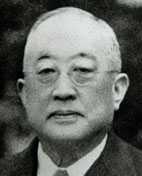Matsudaira Tsuneo
| Matsudaira Tsuneo | |
|---|---|
 | |
| Matsudaira Tsuneo | |
| President of the House of Councillors | |
| In office 1947–1949 | |
| Preceded by | Office Established |
| Succeeded by | Naotake Satō |
| Personal details | |
| Born | April 17, 1877 Tokyo, Japan |
| Died | November 14, 1949 (aged 72) Tokyo, Japan |
| Nationality | Japanese |
| Spouse(s) | Nobuko Nabeshima |
Matsudaira Tsuneo (松平 恒雄, April 17, 1877 – November 14, 1949) was a Japanese diplomat of the 20th century.
Diplomatic and political career
The son of Matsudaira Katamori of Aizu, Tsuneo served as Japanese Ambassador to the United States. In 1929–1935 served as Ambassador to Britain, and in that capacity represented his country at the London Conference on Naval Armaments in 1930. During that conference, he was convinced to accept the ratio in ships which appeared humiliating to the Japanese government through the persuasion efforts of one of the US delegates, Senator James K. Reed, who in return agreed to grant the Japanese government better terms on non-combatant ships.[1]
In 1936–1945 served as head of the Imperial Household Agency. His tenure as head of the Imperial Household Agency ended in resignation on June 4, 1945, after he took responsibility for part of the Imperial Palace burning in the American firebombing of Tokyo. During the last year of the war was among the Japanese leaders who acknowledged that the war was lost and suggested searching for early surrender.[2] After the Second World War, for a brief period in 1946, circles related to the Palace attempted to convince the Liberal Party leadership to promote Matsudaira's candidacy as Prime Minister, but the post was eventually handed to Shigeru Yoshida.[3] Tsuneo served as the first head of the new House of Councillors from the entry into effect of the new Japanese constitution until his death.
Family
Tsuneo was also the father of Matsudaira Setsuko, the wife of Prince Chichibu.
Works
- Matsudaira, Tsuneo. "Sports and Physical Training in Modern Japan," Transactions and Proceedings of the Japan Society, London, 8 (1907/1909), 120
References
- ↑ William Braisted, "On the General Board of the Navy, Admiral Hilary Jones, and Naval Arms Limitation, 1921–1931" The Dwight D. Eisenhower Lectures in War & Peace, No. 4, Kansas State University
- ↑ United States Strategic Bombing Survey, Japan's Struggle to End the War, p. 3
- ↑ Juha Saunavaara, "Occupation Authorities, the Hatoyama Purge and the Making of Japan’s Postwar Political Order" The Asia-Pacific Journal, Vol. 39-2-09, September 28, 2009
External links
- (Japanese)Japanese Wiki article on Tsuneo
- Timeline of Tsuneo's life
- Chichibu, Princess Setsuko. The Silver Drum.
| Preceded by none |
President of the House of Councillors 1947–1949 |
Succeeded by Naotake Satō |